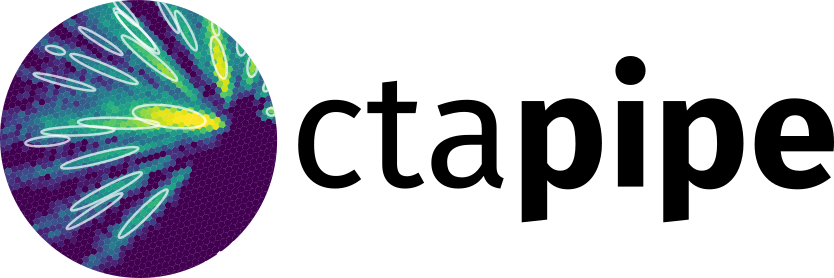SubarrayDescription#
- class ctapipe.instrument.SubarrayDescription(name, tel_positions, tel_descriptions, reference_location)[source]#
Bases:
objectCollects the
TelescopeDescriptionof all telescopes along with their positions on the ground.- Attributes:
- name: str
name of subarray
- tel_coords: ctapipe.coordinates.GroundFrame
coordinates of all telescopes
- tels:
dict of TelescopeDescription for each telescope in the subarray
Attributes Summary
Version numbers supported by
SubarrayDescription.from_hdfCurrent version number of the format written by
SubarrayDescription.to_hdfTuple of unique camera types in the array
area of smallest circle containing array on ground
number of telescopes in this subarray
Tuple of unique optics types in the array
Dictionary mapping tel_ids to TelescopeDescriptions
Telescope positions in
GroundFrameArray of telescope ids in order of telescope indices
Array of telescope indices that can be indexed by telescope id
dictionary mapping telescope ids to telescope index
Tuple of unique telescope types in the array
Methods Summary
from_hdf(path[, focal_length_choice])get_tel_ids(telescopes)Convert a list of telescope ids and telescope descriptions to a list of unique telescope ids.
get_tel_ids_for_type(tel_type)return tuple of tel_ids that have the given tel_type
get_tel_indices_for_type(tel_type)return tuple of telescope indices that have the given tel_type
info([printer])print descriptive info about subarray
multiplicity(tel_mask[, tel_type])Compute multiplicity from a telescope mask
peek([ax])Draw a quick matplotlib plot of the array
read(path, **kwargs)Read subarray from path
select_subarray(tel_ids[, name])return a new SubarrayDescription that is a sub-array of this one
tel_ids_to_indices(tel_ids)maps a telescope id (or array of them) to flat indices
tel_ids_to_mask(tel_ids)Convert a list of telescope ids to a boolean mask of length
n_telswhere the index of the telescope is set toTruefor each tel_id in tel_idstel_mask_to_tel_ids(tel_mask)Convert a boolean mask of selected telescopes to a list of tel_ids.
to_hdf(h5file[, overwrite, mode])write the SubarrayDescription
to_table([kind])export SubarrayDescription information as an
astropy.table.TableAttributes Documentation
- COMPATIBLE_VERSIONS = {'2.0'}#
Version numbers supported by
SubarrayDescription.from_hdf
- CURRENT_TAB_VERSION = '2.0'#
Current version number of the format written by
SubarrayDescription.to_hdf
- camera_types#
Tuple of unique camera types in the array
The entries are ordered by camera name to be deterministic but the order should not be relied on.
- footprint#
area of smallest circle containing array on ground
- n_tels#
number of telescopes in this subarray
- optics_types#
Tuple of unique optics types in the array
The entries are ordered by optics name to be deterministic but the order should not be relied on.
- tel#
Dictionary mapping tel_ids to TelescopeDescriptions
- tel_coords#
Telescope positions in
GroundFrame
- tel_ids#
Array of telescope ids in order of telescope indices
- tel_index_array#
Array of telescope indices that can be indexed by telescope id
I.e. for a given telescope, this array maps the tel_id to a flat index starting at 0 for the first telescope.
tel_index = subarray.tel_index_array[tel_id]If the tel_ids are not contiguous, gaps will be filled in by int minval. For a more compact representation use the
tel_indices
- tel_indices#
dictionary mapping telescope ids to telescope index
- telescope_types#
Tuple of unique telescope types in the array
The entries are ordered by telescope name to be deterministic but the order should not be relied on.
Methods Documentation
- get_tel_ids(telescopes: Iterable[int | str | TelescopeDescription]) tuple[int][source]#
Convert a list of telescope ids and telescope descriptions to a list of unique telescope ids.
- Parameters:
- telescopes: List[Union[int, str, TelescopeDescription]]
List of Telescope IDs and descriptions. Supported inputs for telescope descriptions are instances of
TelescopeDescriptionas well as their string representation.
- Returns:
- tel_ids: List[int]
List of unique telescope ids matching
telescopes
- get_tel_ids_for_type(tel_type) tuple[int][source]#
return tuple of tel_ids that have the given tel_type
- Parameters:
- tel_type: str or TelescopeDescription
telescope type string (e.g. ‘MST_MST_NectarCam’)
- get_tel_indices_for_type(tel_type)[source]#
return tuple of telescope indices that have the given tel_type
- Parameters:
- tel_type: str or TelescopeDescription
telescope type string (e.g. ‘MST_MST_NectarCam’)
- multiplicity(tel_mask, tel_type=None)[source]#
Compute multiplicity from a telescope mask
- Parameters:
- tel_masknp.ndarray
Boolean array with last dimension of size n_telescopes
- tel_typeNone, str or TelescopeDescription
If not given, compute multiplicity from all telescopes. If given, the multiplicity of the given telescope type will be computed.
- Returns:
- multiplicityint or np.ndarray
Number of true values for given telescope mask and telescope type
- peek(ax=None)[source]#
Draw a quick matplotlib plot of the array
- Parameters:
- axmatplotlib.axes.Axes or None
If given, the subarray will be plotted into this ax.
- static read(path, **kwargs)[source]#
Read subarray from path
This uses the
EventSourcemechanism, so it should be able to read a subarray from any file supported by ctapipe or an installed io plugin.kwargs are passed to the event source
- select_subarray(tel_ids, name=None) SubarrayDescription[source]#
return a new SubarrayDescription that is a sub-array of this one
- Parameters:
- tel_ids: list(int)
list of telescope IDs to include in the new subarray
- name: str
name of new sub-selection
- Returns
- ——-
- SubarrayDescription
- tel_ids_to_indices(tel_ids)[source]#
maps a telescope id (or array of them) to flat indices
- Parameters:
- tel_idsint or List[int]
array of tel IDs
- Returns:
- np.array:
array of corresponding tel indices
- tel_ids_to_mask(tel_ids)[source]#
Convert a list of telescope ids to a boolean mask of length
n_telswhere the index of the telescope is set toTruefor each tel_id in tel_ids- Parameters:
- tel_idsint or List[int]
array of tel IDs
- Returns:
- np.array[dtype=bool]:
Boolean array of length
n_telswith indices of the telescopes intel_idsset to True.
- tel_mask_to_tel_ids(tel_mask)[source]#
Convert a boolean mask of selected telescopes to a list of tel_ids.
- Parameters:
- tel_mask: array-like
Boolean array of length
n_telswith indices of the telescopes intel_idsset to True.- Returns
- ——-
- np.array:
Array of selected tel_ids
- to_hdf(h5file, overwrite=False, mode='a')[source]#
write the SubarrayDescription
- Parameters:
- h5filestr, bytes, path or tables.File
Path or already opened tables.File with write permission
- overwriteFalse
If the output path already contains a subarray, by default an error will be raised. Set
overwrite=Trueto overwrite an existing subarray. This does not affect other content of the file. Usemode="w"to completely overwrite the output path.- modestr
If h5file is not an already opened file, the output file will be opened with the given mode. Must be a mode that enables writing.
- to_table(kind='subarray')[source]#
export SubarrayDescription information as an
astropy.table.Table- Parameters:
- kind: str
which table to generate (subarray or optics)
